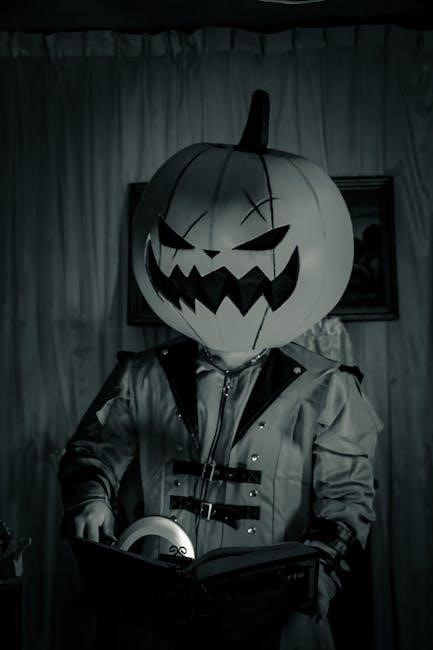Jack and the Beanstalk: Exploring the Classic Tale
“Jack and the Beanstalk” is a timeless fairy tale, captivating readers with its themes of bravery and resourcefulness. Available in numerous PDF versions, the story follows Jack’s journey from poverty to triumph, featuring magical beans, a towering beanstalk, and a fearsome giant.
Origins and Early Versions of Jack and the Beanstalk
The origins of “Jack and the Beanstalk” are deeply rooted in folklore, with early versions appearing in various forms across different cultures. One notable precursor is “Jack Spriggins and the Enchanted Bean,” dating back to 1734. This tale, along with Benjamin Tabart’s moralized rendition, “The History of Jack and the Bean-Stalk” (1807), helped shape the narrative we know today.

Felix Summerly (Henry Cole) further popularized the story, contributing to its widespread appeal. The tale’s enduring nature is evident in its presence in numerous collections and adaptations, including those available as PDF books for children and adults alike. These versions often reflect the cultural context in which they were created, offering diverse interpretations of Jack’s adventures. Examining these early versions provides valuable insight into the evolution and lasting significance of this classic story.
The Story of Jack and the Beanstalk: A Summary
“Jack and the Beanstalk” narrates the journey of a young boy named Jack, who lives with his impoverished mother. To alleviate their financial struggles, Jack is sent to market to sell their only cow. However, he makes an impulsive trade, exchanging the cow for a handful of seemingly magical beans. Upon returning home, his mother, disappointed and frustrated, throws the beans out the window.
Overnight, the beans sprout into an enormous beanstalk that stretches high into the sky. Driven by curiosity, Jack climbs the beanstalk and discovers a giant’s castle at the top. There, he encounters a series of challenges and treasures, including a hen that lays golden eggs and a magical harp. Jack’s adventures involve outwitting the giant and escaping with the treasures, ultimately leading to the beanstalk being chopped down. The story, often available in PDF format, emphasizes themes of courage and resourcefulness.
Jack’s encounter with the man and magic beans
In the tale of “Jack and the Beanstalk,” a pivotal moment occurs when Jack, en route to market to sell his family’s cow, encounters a mysterious man. This encounter marks a turning point in Jack’s fortunes and sets the stage for his extraordinary adventure. The man, often depicted as enigmatic and persuasive, offers Jack a trade that seems too good to be true: magic beans in exchange for the cow.
Intrigued by the promise of something extraordinary, Jack accepts the offer, believing the beans hold a value far greater than mere livestock. The man’s description of the beans as magical seeds that will grow into something amazing captivates Jack’s imagination. This decision, impulsive as it may seem, reflects Jack’s inherent sense of adventure and his willingness to take risks. Upon returning home with the beans, Jack faces his mother’s disappointment. The story, often available in PDF format, highlights this key exchange.
The Giant Beanstalk and its Growth
Following Jack’s exchange for magic beans, the story takes a fantastical turn with the extraordinary growth of the beanstalk. Disappointed with Jack’s trade, his mother throws the beans out the window, unknowingly setting the stage for a magical phenomenon. Overnight, the beans sprout and rapidly ascend, transforming into a colossal beanstalk that stretches far beyond the sky.
The beanstalk’s immense size and rapid growth are a central element of the tale, symbolizing the boundless possibilities that lie beyond the ordinary. Its towering presence dominates the landscape, beckoning Jack to embark on an adventure into the unknown. The beanstalk serves as a bridge between Jack’s humble world and the realm of giants, where danger and riches await. This magical element is often vividly illustrated in PDF versions of the story, capturing the awe-inspiring scale of the beanstalk. Its growth is a testament to the magic inherent in the beans.

Jack’s Climb and Discovery at the Top

Driven by curiosity and a thirst for adventure, Jack begins his arduous climb up the gigantic beanstalk. The ascent is challenging, requiring strength and determination as he grasps onto the thick, winding stalk. Higher and higher he climbs, leaving his familiar world behind and venturing into the clouds. The illustrations often found in PDF versions of “Jack and the Beanstalk” vividly depict this perilous journey, emphasizing the sheer height and the sense of wonder.
Reaching the top, Jack discovers a new and unfamiliar land, a realm high above the earth. Before him lies a path leading to a towering castle, the home of the giant. This discovery marks a pivotal moment in the story, as Jack steps into a world of both danger and opportunity. The top of the beanstalk represents a threshold, a gateway to the unknown where Jack’s courage and wit will be tested. The climb itself symbolizes Jack’s ambition and his willingness to overcome obstacles in pursuit of a better life.
The Giant’s Castle and its Treasures
At the top of the beanstalk, Jack finds himself before a colossal castle, the dwelling of the fearsome giant. This castle is not merely a home; it is a repository of stolen treasures, symbols of the giant’s greed and power; Inside, Jack discovers a hen that lays golden eggs, a magical harp that plays beautiful music, and bags overflowing with gold coins. These treasures represent not only wealth but also the potential for a better life for Jack and his mother.
The illustrations in many PDF versions of “Jack and the Beanstalk” vividly portray the grandeur and opulence of the giant’s castle, emphasizing the contrast between Jack’s humble home and the giant’s extravagant lifestyle. The presence of these treasures highlights the theme of social inequality and the desire for a more equitable distribution of wealth. The castle itself becomes a symbol of the giant’s dominance and the injustice that Jack seeks to overcome.
Jack’s Encounters with the Giant’s Wife
In the giant’s castle, Jack’s path crosses with the giant’s wife, a character who often embodies a sense of moral ambiguity. Initially, she provides Jack with food and shelter, offering him a moment of respite from the dangers of the giant’s domain. Her actions can be interpreted as acts of kindness or perhaps self-preservation, as she may fear the giant’s wrath if she were to betray Jack outright.
These encounters are crucial to the plot, allowing Jack to gain access to the giant’s treasures. The giant’s wife often warns Jack about her husband’s nature, revealing the giant’s penchant for eating humans. This information heightens the suspense and underscores the peril Jack faces.
Many PDF versions of “Jack and the Beanstalk” depict the giant’s wife in various ways, ranging from a sympathetic figure to a more complicit accomplice. Her role adds complexity to the narrative, challenging the simple good-versus-evil dichotomy. Jack’s interactions with her require him to exercise caution and cunning, further developing his character.
Jack Stealing the Treasures: Hen, Harp, and Gold
Driven by poverty and a desire to improve his and his mother’s lives, Jack embarks on a series of daring thefts from the giant. These treasures—a hen that lays golden eggs, a self-playing harp, and bags of gold—represent not only wealth but also magical solutions to their financial woes. Each stolen item brings Jack closer to securing a better future.
The hen that lays golden eggs symbolizes prosperity and ongoing wealth, providing a sustainable source of income. The self-playing harp represents beauty, music, and perhaps even a touch of enchantment brought back into their humble home. The bags of gold offer immediate relief from their poverty, allowing them to purchase necessities and live more comfortably.
These acts of theft, often depicted vividly in PDF versions of the story, raise moral questions about Jack’s actions. While his motives are understandable, the act of stealing remains a point of ethical debate. The treasures become symbols of both hope and the potential consequences of acquiring wealth through questionable means. Each successful heist increases the tension and sets the stage for the giant’s inevitable pursuit.
The Giant’s Pursuit and Jack’s Escape
After Jack steals the treasures, the giant awakens to the loss and gives chase, his heavy footsteps shaking the very ground. This pursuit is a thrilling climax, embodying the consequences of Jack’s actions and the giant’s wrath. The chase down the beanstalk is a race against time, with Jack desperately trying to reach the bottom before the giant catches him.
The imagery of the giant descending the beanstalk is often depicted dramatically in PDF illustrations, emphasizing the sheer size and menace of the pursuer. Jack’s agility and knowledge of the terrain give him a slight advantage, but the giant’s immense strength and determination make the outcome uncertain. The harp’s cries warning of the giant’s approach add to the suspense, highlighting the magical nature of the stolen treasures.

As Jack nears the bottom, the tension reaches its peak. He knows that his escape depends on reaching the ground and taking decisive action. The giant’s pursuit represents not only a physical threat but also the looming consequences of greed and defiance. The escape is a test of Jack’s courage and resourcefulness, setting the stage for the final act of the story.
Chopping Down the Beanstalk
Reaching the ground, Jack knows he must act quickly to prevent the giant from descending further. He calls for an axe, and with swift, determined blows, he begins to chop at the base of the beanstalk. This act is a critical turning point, symbolizing Jack’s final triumph over the giant and the end of the threat to his world. The illustrations in various PDF versions often depict this scene with dynamic energy, showing Jack’s strength and resolve as he swings the axe.
The beanstalk, once a symbol of magical opportunity, now becomes a target for destruction, representing the severing of ties with the dangerous world above. As the beanstalk begins to fall, the giant plummets to his demise, marking the definitive end to his reign of terror. The sound of the falling beanstalk and the giant’s earth-shaking thud emphasize the finality of the event.
This act demonstrates Jack’s bravery and his commitment to protecting his community. Chopping down the beanstalk is not just an act of self-preservation; it’s an act of responsibility. It ensures that the giant can never again threaten his home, restoring peace and security; The finality of this action allows Jack and his mother to enjoy the treasures he has acquired, free from fear.
Moral and Interpretations of Jack and the Beanstalk
“Jack and the Beanstalk” is a story rich with symbolism, leading to diverse interpretations. One prominent moral revolves around the themes of courage and resourcefulness. Jack, faced with poverty, dares to climb the beanstalk, demonstrating bravery in the face of the unknown. His cleverness in outwitting the giant highlights the value of intelligence and adaptability. These themes are often explored in educational PDF versions of the tale.
Another interpretation focuses on the dangers of greed and the consequences of impulsive actions. Jack’s initial trade of the cow for magic beans can be seen as a foolish decision, driven by a desire for quick riches. The giant represents the embodiment of greed, hoarding treasures and threatening those around him. In some interpretations, the story serves as a cautionary tale against unchecked ambition.
Furthermore, the story can be viewed through a socio-economic lens, examining the power dynamics between the poor and the wealthy. Jack’s actions can be interpreted as a rebellion against social inequality, as he seeks to improve his family’s circumstances by challenging the giant’s dominance. Ultimately, “Jack and the Beanstalk” offers a multifaceted narrative that continues to resonate with readers, prompting discussions about morality, social justice, and the human spirit.